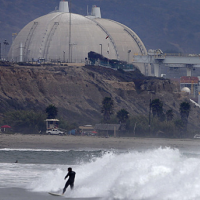Coastal Commission OKs Seaside Storage of Spent San Onofre Nuclear Fuel
 San Onofre Nuclear Generating Station (photo: Gregory Bull, Associated Press)
San Onofre Nuclear Generating Station (photo: Gregory Bull, Associated Press)
Southern California Edison has a plan to handle spent nuclear fuel left over after closure of the San Onofre Nuclear Generating Station, and the California Coastal Commission likes it.
Edison wants to move 2,700 spent fuel assemblies from above-ground pools to steel canisters, wrapped in concrete, topped with steel and more concrete, and buried beneath the bluffs between Los Angeles and San Diego. The waste will lay 125 feet from a seawall and be dangerously radioactive for thousands of years.
The commission voted on Tuesday to approve construction of what one critic called “America’s largest beach-front nuclear waste dump,” but all the members didn’t sound like they had their heart in it. The Orange County Register quoted Commissioner Greg Cox as saying:
“I do have to conclude that the worst scenario is to leave this material in the spent fuel pools. That’s the worst of all alternatives out there. I wish there were other options available now.”
The plan is to bury the dangerously radioactive material for at least 20 years, until some place can be found to permanently move it that doesn’t have 8.4 million people living within 50 miles of unmonitored, unfixable, thin, decaying steel canisters holding nuclear fuel in earthquake-tsunami country.
The federal government argued for decades over building a national facility for disposing of nuclear waste piling up all around the country. That didn’t happen. Democrats in the Senate and White House have blocked congressional Republicans from establishing Yucca Mountain, 100 miles from Las Vegas, as a national nuclear waste site. President Trump could change that in 2016.
Opponents of the San Onofre plan suggested moving the fuel to Edison’s Palo Verde nuclear plant in Arizona, ship it to a waste storage facility being planning for Texas or find some spot in the desert to bury it. None of those options received serious consideration. There have also been suggestions that if Edison were going to bury the waste seaside, the use European storage methods.
European nations reprocess a lot of its fuel, so they store the waste in containers that are accessible and can be monitored. The steel canisters are also 20” thick, compared to the thin technology favored by Edison that is up to ⅝” thick. Edison’s containers would not be accessible and could not be monitored.
The commission only approved storage until 2035. By then, Edison is expected to have better options and a new plan. If they don’t, they can build new containers and transfer the material at a cost (to taxpayers, no doubt) of hundreds of millions of dollars.
Commission staff estimated that the shoreline would erode 29 feet by then, according to the San Diego Union-Tribune, but that’s only one-fourth the distance to the nuclear fuel. The commission’s decision to grant Edison a permit to bury the waste is expected to be challenged in court.
–Ken Broder
To Learn More:
State OKs Burying Nuclear Waste at Beach (by Morgan Lee, San Diego Union-Tribune)
Watchdog: Nuclear Waste Can Be Stored at New San Onofre Site, Coastal Commission Says (by Teri Sforza, Orange County Register)
Coastal Commission to Vote on Expanded Nuclear Fuel Storage at San Onofre (by Alison St John, KPBS)
Edison Has “Short-Sighted” Plan for Indefinitely Burying San Onofre Nuclear Waste (by Ken Broder, AllGov California)
- Top Stories
- Controversies
- Where is the Money Going?
- California and the Nation
- Appointments and Resignations
- Unusual News
- Latest News
- California Forbids U.S. Immigration Agents from Pretending to be Police
- California Lawmakers Urged to Strip “Self-Dealing” Tax Board of Its Duties
- Big Oil’s Grip on California
- Santa Cruz Police See Homeland Security Betrayal in Use of Gang Roundup as Cover for Immigration Raid
- Oil Companies Face Deadline to Stop Polluting California Groundwater





